When we think of a traditional vegetable garden, we tend to think of plump, round tomatoes or verdant rows of cabbage growing in a sun-drenched yard. But if you live in an urban area, you’ll need to think outside the box—or inside the container.
Container gardening affords apartment dwellers the opportunity to grow their own food, which has a number of personal and far-reaching benefits, including:
- Spending less money on pricey produce at the grocery store.
- Reducing your carbon footprint.
- Creating less food waste.
- Eating healthy, organic, better-tasting food.
For the health- and environmentally-conscious, edible gardening just makes sense. But, like anything worth doing, container gardening takes work. Even to the seasoned gardener, growing vegetables in pots presents its own set of unique challenges.
If you’re a novice, or if you’ve killed every plant you’ve ever owned (cacti included), don’t worry: we’ve put together a comprehensive guide to get you started.
First, take a look at the flow chart below:
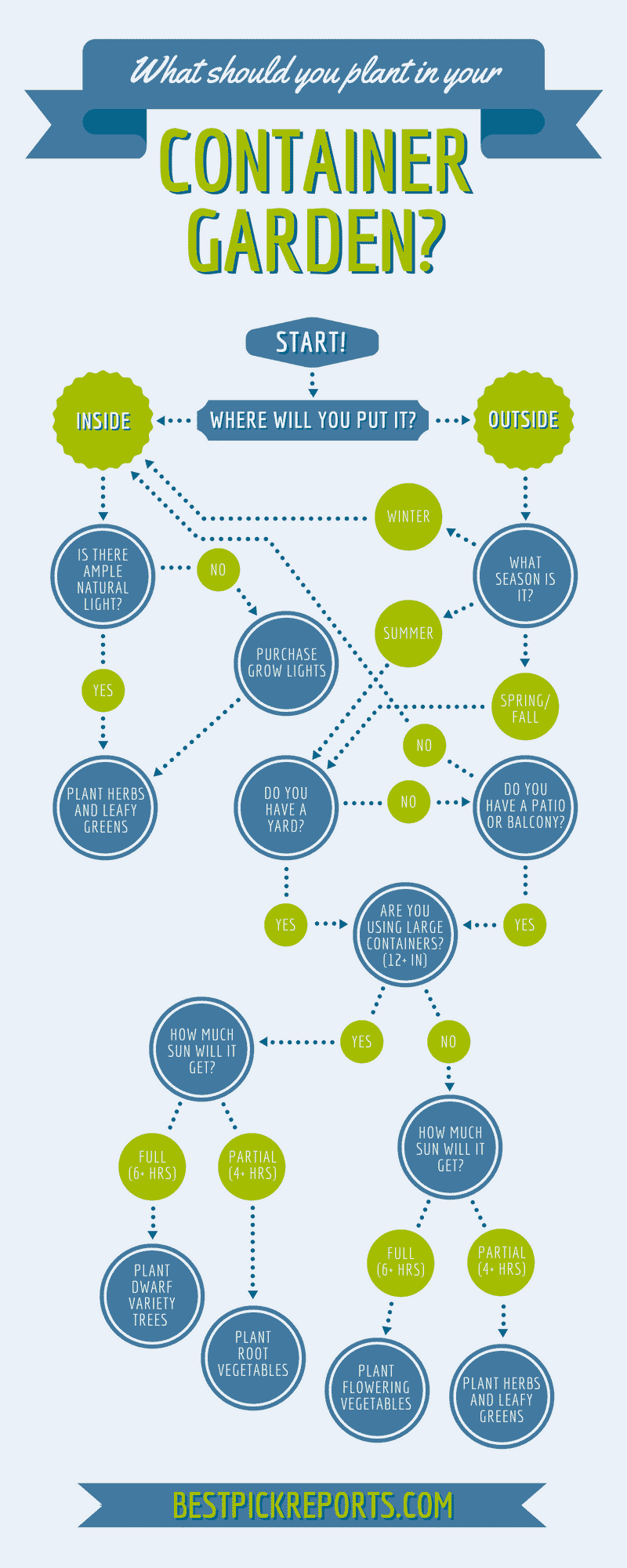
Choose the Right Plants for Your Container Garden
What are the best vegetables to grow in pots? The short answer is: it depends. External factors, such as sun exposure and container size, are extremely important to the health and longevity of your garden and determine, to an extent, what types of plants you’ll be able to grow.
Once you figure out where you’ll put your garden, observe how much sunlight the area receives throughout the day. Most fruits and vegetables require full sun, but some are more shade tolerant and therefore better suited for indoor gardens.
Full Sun
Vegetables: Many common vegetables require full sun, or at least six hours of direct sunlight per day. This includes any plants that fruit from a flower, such as tomatoes, peppers, eggplant, cucumber, zucchini, squash, and broccoli.
Fruits: Fruit trees are available in dwarf or patio varieties that fare quite well in containers. You’ll want to start them in a five- to seven-gallon pot, then transfer them to a large container—ten to fifteen gallons—when you notice a lull in vertical growth.
Place the trees somewhere they’ll receive six to eight hours of sunlight a day. Be sure, of course, that you can move them indoors by a sunny window during the winter.
Because they are compact and grow quickly, strawberries are a popular choice for small-scale container gardening. It is also possible to grow blackberry and raspberry bushes on a deck or patio using large containers and trellises. Like fruit trees, berries require a full six to eight hours of sunlight.
Partial Sun
Root vegetables, like potatoes, carrots, and beets, are tolerant of partial sunlight (four or more hours of direct sunlight per day), but require containers at least twelve inches deep to accommodate their extensive root systems.
Filtered Sun
Of the edible plants, herbs, such as rosemary, basil, parsley, chives, and thyme, and leafy greens, like spinach, lettuce, and kale, are the most shade tolerant. These plants can grow in small containers and in areas that receive filtered sunlight, such as a windowsill or shady balcony.
Gardening Indoors

If you don’t get enough natural sunlight, or if it’s too cold for outdoor planting, grow lights provide an alternative to successfully growing edible plants outside. There are several types of grow lights suitable for residential gardening, each with their own pros and cons.
- Incandescent grow lights are inexpensive, but they are less efficient, give off quite a bit of heat, and do not last as long as fluorescent lights or LEDs.
- Fluorescent grow lights produce a low heat output and last around 10,000 hours.
- LED grow lights are the most energy-efficient choice. They produce very little heat and have an average lifespan of 50,000 hours. The light spectrum of LED grow lights makes them perfect for indoor gardening.
A Note on Variety
When you’re buying seeds, read the labels carefully. Look for bush, dwarf, patio, trailing, or miniature varieties to ensure you purchase plants intended for containers. If you’re unsure, ask for these varieties at your local garden supply store, or order your plants or seeds online.
Gardening Essentials to Get Started
Before you begin potting, you’ll need:
- Gardening gloves
- A trowel
- Trellises (for non-bush variety vines, like tomatoes, peppers, and cucumbers)
- Potting soil
- Balanced (10-10-10) liquid fertilizer
Use Potting Soil/Potting Mix to Grow in Containers
More so than plants grown in the ground, container-grown plants are quick to wilt. Potting soil is mixed with water-retentive elements, such as peat moss, to help prevent drying, and it also contains a balance of nutrients.
Note: Some potting mixes are specific to certain types of plants, but in general, all-purpose mixes work perfectly well for growing vegetables.
Fertilizing Potted Plants
Because container-grown plants tend to dry out quickly, they naturally require more water than crops grown in the ground. Avoid dry fertilizers, as they are prone to erosion with frequent watering, and opt for a fertilizer solution when it is time to give your plants a nutrient boost.
If you’re growing in high-quality, nutrient-rich potting soil, adding a liquid fertilizer to your watering can once every two weeks will keep your plants productive and healthy.
What Types of Containers Work for Gardening?
There are many options when assembling containers for your garden—more than you might think. With added holes for drainage, a galvanized steel bucket or a vintage washtub, for example, could house your plants and double as eclectic decoration.
Remember: Consider the size of the container. Root vegetables and fruit trees need large containers to thrive, and non-bush variety vine-grown vegetables require a vessel with enough surface area to accommodate trellises.
Traditional Containers
There are containers available for every budget at garden supply stores, each with their own characteristics.
- Plastic nursery pots are cheap and lightweight, so they are easily transferred indoors and out when necessary.
- Terra cotta pots are similarly light and inexpensive, but they tend to retain heat, which dries out plants more quickly. Growing in terra cotta may necessitate extra watering.
- Stone, marble, or concrete containers are as attractive and sturdy as they are expensive. These pots are also heavy and difficult to move, though they can be placed on rolling stands for easy maneuvering.
Upcycled Containers
Of course, the least expensive—and the most environmentally conscious—alternative is using what you have on hand. Chances are, there is at least one of the following reusable containers in your home or recycling bin already:
- Coffee or paint cans
- Glass canning jars
- Milk jugs or soda bottles (cut in half)
- Wooden wine crates
- Plastic or galvanized metal buckets
- Storage bins
- Hanging shoe organizers

Repurposing vintage containers from flea markets and antique stores presents another creative option. Look for the following:
- Teacups and teapots
- Bowls, basins, tureens, and jars
- Washtubs
- Beverage tubs
Maximizing Drainage
Novice gardeners commonly make the mistake of over-watering their plants, and too much water can be just as harmful as too little. When it is over-saturated, the root system becomes waterlogged and begins to rot, so containers must have ample drainage to disperse excess water.
Traditional pots are designed to allow drainage, but if you are using an unconventional container, be sure to punch or drill several holes into the bottom. If you do not have the tools to do so without causing damage, plant in nursery pots instead, and then place the nursery pots inside the repurposed containers. Remember to pour out the excess after each watering.
Watering Tips for Container Gardens
Many factors—element exposure, container material, soil content, etc.—influence how quickly a plant dries out, so it can be difficult to know when and how much to water. Container-grown crops are particularly susceptible to over- and under-watering, so try these methods if you’re unsure:
- Top watering: Apply water to the surface of the soil until it leaks out of the holes at the bottom, then pour out the extra.
- Bottom watering: Place the container in a saucer of water and add water when the saucer is dry.
- Wait for wilt: Add water when the plant begins to show signs of drying out.
- Weigh the pot: Pick up the container; if it feels light, it may be time to water.
Anyone Can Garden with Containers
Know this: Just because your space is limited doesn’t mean your eating habits have to be. If you live in a cheek-to-jowls city apartment, gardening in containers makes growing your own food possible—and it reduces your environmental impact.
That’s a win-win for going green.
Once you have your location, tools, and containers, get started with easy-to-grow edible plants, and get started living a cleaner, healthier life.
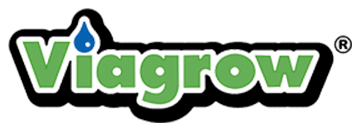
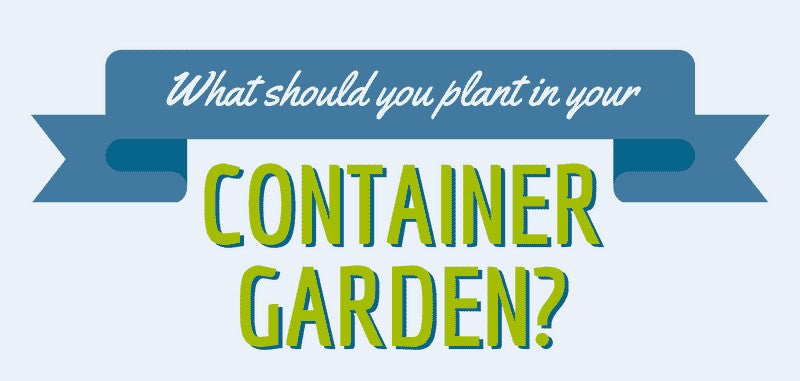
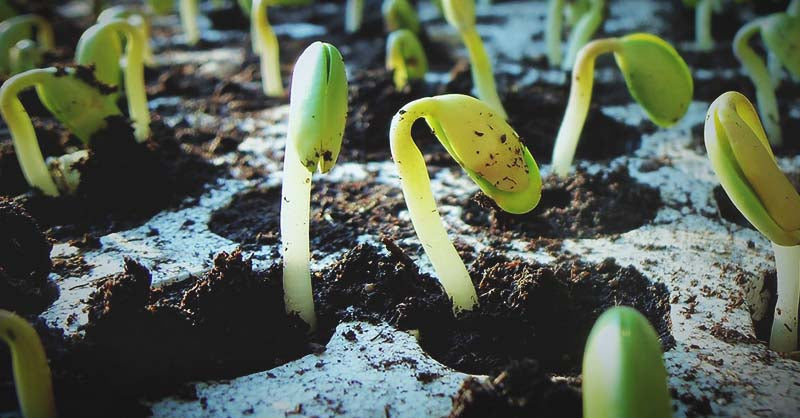

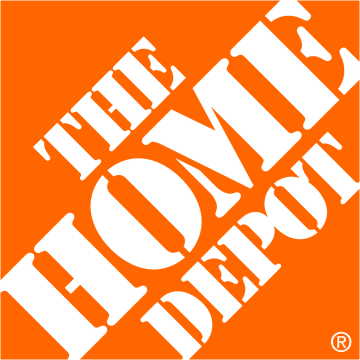





Leave a comment
All comments are moderated before being published.
This site is protected by hCaptcha and the hCaptcha Privacy Policy and Terms of Service apply.